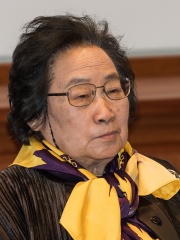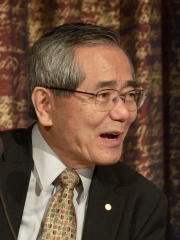


The Most Famous
CHEMISTS from China
Top 3
The following people are considered by Pantheon to be the most legendary Chinese Chemists of all time. This list of famous Chinese Chemists is sorted by HPI (Historical Popularity Index), a metric that aggregates information on a biography's online popularity.

1. Tu Youyou (b. 1930)
With an HPI of 74.88, Tu Youyou is the most famous Chinese Chemist. Her biography has been translated into 85 different languages on wikipedia.
Tu Youyou (Chinese: 屠呦呦; pinyin: Tú Yōuyōu; born on December 30, 1930, in Ningbo, Zhejiang province) is a Nobel Prize-winning malariologist and pharmaceutical chemist and member of the China Academy of Chinese Medical Sciences. She received the Nobel Prize for Physiology or Medicine in 2015 for her discovery and development of artemisinin and related compounds. Tu pursued her education in pharmaceutical sciences at the Peking University School of Medicine (Beijing Medical College) and later focused on traditional Chinese medicine at the Institute of Materia Medica. Her achievements and experience have inspired other researchers and emphasized the development of traditional Chinese medicine. Malaria is caused by a single-cell parasite that causes severe fever. During the Vietnam War in 1967, China and Vietnam were significantly affected by malaria, with approximately 30 million cases and 300,000 deaths just from China. Scientists worldwide had screened over 240,000 compounds without success for finding a cure. She then investigated the history of Chinese medical classics, visiting practitioners of traditional Chinese medicine across the country on her own. She gathered her findings in a notebook titled "A Collection of Single Practical Prescriptions for Anti-Malaria." By 1971, her team had screened over 2,000 traditional Chinese recipes and made 380 herbal extracts, from some 200 herbs, which were tested on mice. Finally, she discovered breakthrough medicines, artemisinin and dihydroartemisinin, used to treat malaria. In the 1970s, after studies of traditional herbal medicines, Tu Youyou focused on sweet wormwood and extracted a substance, artemisinin, that inhibits the malaria parasite. Artesunate is special among artemisinin-based drugs because it dissolves in water, allowing rapid absorption into the body. The fast absorption enables the doctor to inject the medicine into a vein, muscle, or rectum; moreover, severe malaria can cause symptoms that deteriorate quickly, and patients can't take medicine orally. Artemisinin-based medication has led to the survival and improved health of millions of people. This treatment saved millions of lives in South China, Southeast Asia, Africa, and South America. Until now, artemisinin and its derivatives remain the most important and widely used drugs for the treatment of malaria. However, artemisinin requires ongoing research into new therapies because parasites are showing resistance. Medicines for Malaria Venture (MMV) further discovers and develops the project from the discovery of Tu Youyou. MMV's strategy to 2030 aims to cure, prevent, and eliminate malaria by developing a strong pipeline of future medicines.

2. Ei-ichi Negishi (1935 - 2021)
With an HPI of 71.28, Ei-ichi Negishi is the 2nd most famous Chinese Chemist. His biography has been translated into 63 different languages.
Ei-ichi Negishi (根岸 英一, Negishi Eiichi; 14 July 1935 – 6 June 2021) was a Japanese chemist who was best known for his discovery of the Negishi coupling. He spent most of his career at Purdue University in the United States, where he was the Herbert C. Brown Distinguished Professor and the director of the Negishi-Brown Institute. He was awarded the 2010 Nobel Prize in Chemistry "for palladium catalyzed cross couplings in organic synthesis" jointly with Richard F. Heck and Akira Suzuki.

3. Edmond H. Fischer (1920 - 2021)
With an HPI of 71.19, Edmond H. Fischer is the 3rd most famous Chinese Chemist. His biography has been translated into 49 different languages.
Edmond Henri Fischer (April 6, 1920 – August 27, 2021) was a Swiss-American biochemist. He and his collaborator Edwin G. Krebs were awarded the Nobel Prize in Physiology or Medicine in 1992 for describing how reversible phosphorylation works as a switch to activate proteins and regulate various cellular processes. From 2007 until 2014, he was the Honorary President of the World Cultural Council. At the time of his death at age 101 in 2021, he was the oldest living Nobel Prize laureate.
People
Pantheon has 3 people classified as Chinese chemists born between 1920 and 1935. Of these 3, 1 (33.33%) of them are still alive today. The most famous living Chinese chemists include Tu Youyou. The most famous deceased Chinese chemists include Ei-ichi Negishi, and Edmond H. Fischer.

